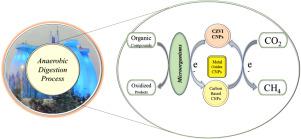Environmental Technology & Innovation ( IF 6.7 ) Pub Date : 2021-04-05 , DOI: 10.1016/j.eti.2021.101526 Pramod Jadhav , Nurmunira Muhammad , Prakash Bhuyar , Santhana Krishnan , Abdul Syukor Abd Razak , A.W. Zularisam , Mohd Nasrullah

|
The development of the anaerobic digestion (AD) process and its mild operating conditions of complex organic carbon distinguish it from conventional energy technologies and make it highly desirable to meet a sustainable green energy technology. Although, the effectiveness of this AD method is often constructed by few issues such as surface heterogeneity, ammonia inhibition, poor methane production, slow microbe growing rates, and slow mass transfer which needs rectification. Conductive nanoparticles (CNPs) helps to increase anaerobic digestion rates as nano-sized structures with specific physicochemical properties interact with the substrate and microorganisms. CNPs as additive have resulted in high efficiency for the AD process because of their unique physicochemical characteristics, i.e. high surface area, high active sites, high reactivity levels, high specificity, self-assembly, increased mobility, and AD media transmission. This review concentrates on the recent attempts to examine the impact of CNPs, pro and cons on biogas production while using a metal oxide, zero-valent metals, and nano-carbon materials. The traditional view of binding CNPs to living organisms and the current view of mechanisms for improving aerobic digestive performance with metal CNPs. Furthermore, the effect of the physical parameter and kinetic limitations has discussed by the mathematical modeling that essential to observe, optimize simulate, and predict the behavior of microbes at different conditions in the AD process. Later the methanogenic activity and chemical content inhibition of CNPs on the AD system was discussed. Finally, future prospects and other recommendations discussed as conclusive remarks, which help in the substantial use of CNPs to the AD process.
中文翻译:

导电纳米颗粒(CNP)在厌氧消化中的影响综述:应用和局限性
厌氧消化(AD)工艺的发展及其复杂的有机碳的温和操作条件使其与传统能源技术区分开来,因此非常需要满足可持续的绿色能源技术。虽然,此AD方法的有效性通常是由几个问题来构造的,例如表面异质性,氨气抑制,甲烷生成不良,微生物生长速度缓慢以及传质缓慢,这需要进行纠正。导电纳米颗粒(CNP)有助于提高厌氧消化率,因为具有特定理化特性的纳米结构与底物和微生物相互作用。CNP作为添加剂,由于其独特的理化特性(即高表面积,高活性位点,高反应水平,高特异性,自组装,增加的移动性和AD媒体传输。这篇综述集中在最近的尝试中,研究了使用金属氧化物,零价金属和纳米碳材料时,CNP,利弊对沼气生产的影响。将CNP与活生物体结合的传统观点以及使用金属CNP改善有氧消化性能的机理的当前观点。此外,物理模型和动力学限制的影响已通过数学模型进行了讨论,这对于观察,优化模拟和预测AD过程中不同条件下的微生物行为至关重要。随后讨论了CNP在AD系统上的产甲烷活性和化学含量抑制作用。最后,











































 京公网安备 11010802027423号
京公网安备 11010802027423号